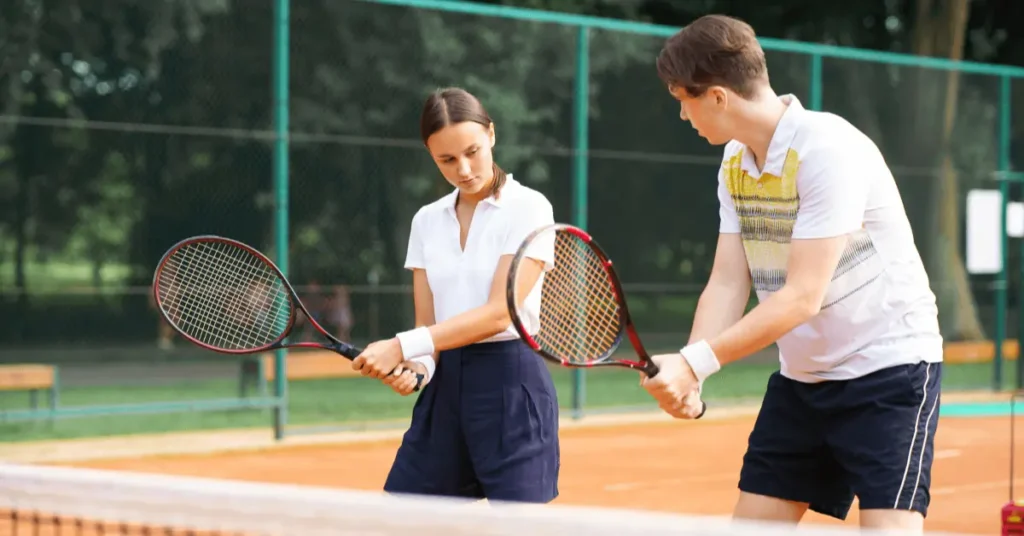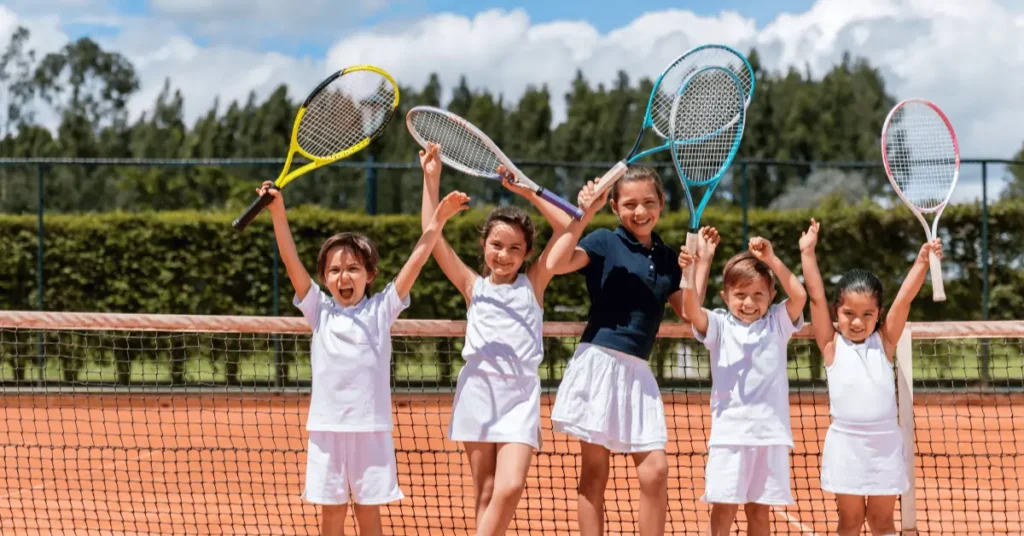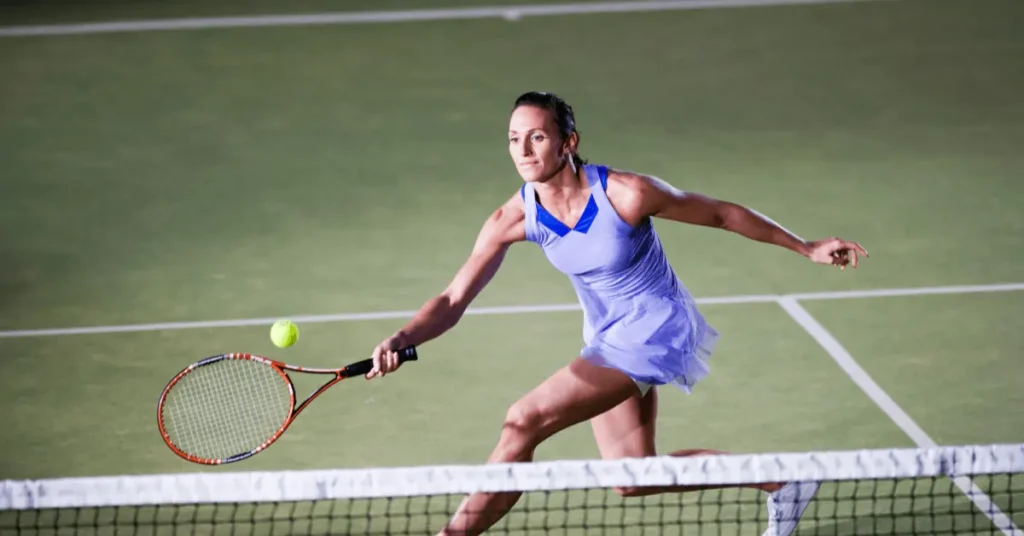Choosing the right tennis racket is the first step to success on the court. As the newbies are not well aware of the gear, it is quite tricky to choose a tennis racket at the start of their gaming career.
The selection process may seem daunting for beginners, especially kids and adults who are just starting their tennis journey. With numerous options available, it’s necessary to know many factors including weight, length, grip size, head size, and many others.
Before buying a tennis racket for a beginner, adult, or kid, you should consider the racket’s head, grip size, balance, weight, material, and string pattern.
After a lot of research and trying out different racquets myself as a beginner, I’m about to share some valuable insights with my likes.
Choosing A Tennis Racket For Beginners
Choosing the right tennis racket as a beginner is essential in setting yourself up for an enjoyable and successful tennis game. With various rackets available in the market, it is crucial to understand the key considerations that can help you make a good decision.

Grip Size:
The right grip size is important to prevent potential injuries and ensure comfort. Beginners should consider going for grip sizes ranging from 4 1/8 to 4 3/8 inches, with smaller sizes. Smaller sizes offer more control, and larger sizes provide increased comfort.
Read More: WTA Women’s Singles Tennis Rankings
String Pattern:
A more open string pattern (16×19 or 16×18) is recommended for beginners, offering enhanced spin potential and reasonable response. This can help compensate for a beginner’s slower swing speed and support generating spin and depth on shots.
Frame Material:
Graphite rackets are popular for beginners due to their lightweight nature and comfortable feel. Graphite offers a good blend of stiffness and flexibility and gives beginner players an optimal balance of power and control.
Weight and Balance:
Lighter racquets with a balanced weight distribution are ideal for beginners. A racket weight ranging from 9 to 10.5 ounces (unstrung) offers maneuverability and reduces arm fatigue risk during extended play.
Consider the Head Size:
Beginners should go for a racket that has a head size larger than the regular ones, between 100-110 square inches. A larger head size provides a more forgiving sweet spot and makes it easier to connect with the ball and generate power, especially on off-center hits.
Budget Considerations:
While investing in a quality racket is essential, beginners should consider their budget and look for a racket that offers good performance within their price range. Many entry-level rackets provide excellent value without going hard on your pockets.
Remember, the right racket can enhance the learning experience and set beginners on the path to developing their tennis skills with confidence and enjoyment. So, it is recommended to always make a uniform decision after trying out some good racquets that match your skill level.
Seek Professional Advice:
Beginners can benefit from seeking advice from a qualified tennis instructor or coach. An instructor can help you assess the beginner’s playing style and recommend a suitable racket that goes with your strengths and areas for improvement.
Read More: Tennis Ball Boys and Girls Salaries
Comfort and Arm Friendliness:
Beginners should prioritize comfort and arm friendliness when selecting a racket. Rackets with built-in vibration-dampening technology can help reduce the risk of arm discomfort and provide a more enjoyable playing experience.
| Consideration | Recommendation | Reasons |
| Head Size | Beginners: Opt for a larger head size (100-110 sq inches) for a forgiving sweet spot and easier ball connection. | A larger head size provides more forgiveness and better performance. |
| Weight and Balance | Ideal for Beginners: Lighter racquets (9-10.5 oz) with balanced weight distribution for maneuverability and less arm fatigue. | Balanced weight ensures easy handling and reduces strain on the arm. |
| Grip Size | Recommended for Beginners: Grip sizes between 4 1/8 to 4 3/8 inches. Smaller sizes offer control; larger sizes provide comfort. | Proper grip size minimizes the risk of hand discomfort and injuries. |
| Frame Material | Popular Choice: Graphite rackets for a lightweight, comfortable feel. Offers a balance of stiffness and flexibility for beginners. | Graphite gives beginners a good mix of power, control, and comfort. |
| String Pattern | Recommended: More open string patterns (16×19 or 16×18) for enhanced spin potential and good response for beginners. | Open string pattern aids in generating spin and overall shot control. |
| Comfort and Arm Friendliness | Priority for Beginners: Choose rackets with vibration-dampening technology to reduce arm discomfort and enhance the playing experience. | Vibration-dampening tech minimizes shock and ensures a comfortable feel. |
| Seek Professional Advice | Beneficial: Consult a qualified tennis instructor or coach to assess playing style and get personalized recommendations. | Expert advice helps tailor choices to individual playing needs and styles. |
| Budget Considerations | Important: Consider budget while investing in a quality racket. Entry-level racquets offer excellent value for beginners. | Quality rackets within budget provide a cost-effective entry for beginners. |
Choosing A Tennis Racket For Kids
When choosing a tennis racket for your kid, here are a few things that you should take into consideration:

Head Size:
Choose rackets with larger head sizes (in square inches) to offer a larger sweet spot and enhance forgiveness on off-center hits. A larger head provides more power but less control. So, ask your kids to always try out a few swings to get used to the control factor of the racket.
Read More: Tennis Players With Big Breasts
Grip Size:
Considering the grip size for your kid is very important. Always go for smaller grip sizes to make sure your kid has a comfortable and secure grip for their smaller hands. Grip sizes typically range from 4 inches to 4 3/8 inches for kids.
Racket Length:
Consider shorter racket lengths to accommodate the smaller size of children. Racket lengths for kids are typically available in 19 to 25 inches.
Weight and Balance:
Lighter rackets with a balanced weight distribution help kids swing the racket with ease. It is essential to consider rackets weighing between 6 to 8 ounces for your kids to avoid putting any extra possible pressure on their arms.
Material and Construction:
Durable, lightweight materials such as aluminum or graphite composite are ideal for kids’ rackets. So kids can experience durability and easy handling as well.
String Pattern and Tension:
A more open string pattern (16×19 or 16×17) for your kids is highly recommended to go for. This will help in generating higher power and more spin. Additionally, always go for lower string tension for added comfort and forgiveness.
| Consideration | Recommendation | Kid’s Specs | Additional Insights |
| Grip Size | Smaller grip sizes (4 inches to 4 3/8 inches) for comfortable and secure grip suitable for smaller hands. | Grip Size: 4 inches to 4 3/8 inches | Proper grip size ensures comfort and prevents hand strain. |
| Racket Length | Shorter racket lengths (19 to 25 inches) to accommodate children of smaller sizes. | Length: 19 to 25 inches | The shorter length allows better handling for young players. |
| Head Size | Larger head sizes for a larger sweet spot and forgiveness on off-center hits. | Head Size: Larger (in square inches) | A larger head size balances power and forgiveness. |
| Weight and Balance | Lighter racquets with balanced weight distribution (6 to 8 ounces) for accessible swings and less arm pressure. | Weight: 6 to 8 ounces, Balanced | Lightweight design promotes proper technique for kids. |
| Material and Construction | Durable, lightweight materials such as aluminum or graphite composite for durability and ease of handling. | Material: Aluminum or Graphite Composite | Durable materials ensure longevity for kids’ rough use. |
| String Pattern and Tension | More open string patterns (16×19 or 16×17) for generating spin and power. Lower string tension for added comfort and forgiveness. | String Pattern: 16×19 or 16×17, Lower Tension | An open string pattern aids in spin and lower tension for comfort. |
Choosing A Tennis Racket For Adults
Factors to consider before buying a tennis racket as an adult:

Grip Size:
Measure the grip size by holding the racket in a ready position. The ideal grip size should allow for a slight gap between the fingertips and palm when gripping the handle. Commonly the essential adult grip sizes are size 3(⅜) and size 4 (½).
Read More: US Open Tennis Winners List
Head Size:
Select head sizes that balance power and control. Midsize rackets (85-95 square inches) may provide you with better precision. Whereas, oversize rackets (106-135 square inches) may offer you more power and forgiveness.
Racket Length:
Standard adult racket lengths are around 27 inches, but beginner adults also opt for a slightly longer racket to increase reach and power.
Weight and Balance:
Beginner adult tennis players may prefer slightly lighter rackets for improved maneuverability. So, it is essential for rackets weighing between 9 to 10.9 ounces with a balanced or slightly head-heavy balance for stability and power.
Material and Construction:
Beginner adult players should go for graphite or graphite composite rackets. You get a combination of balance, power, and control by these rackets with enhanced shock absorption.
Read More: ATP Singles Men’s Tennis Rankings
String Pattern and Tension:
Consider string patterns based on playing style. You get more spin in open string patterns and if the pattern is dense, you get high control. Lower string tension is suitable for beginner adult players to enhance comfort and power.
| Consideration | Recommendation | Adult Specs | Reasons |
| Grip Size | Measure grip size by holding the racket, allowing a slight gap between fingertips and palm. Common sizes: 3(⅜) and 4(½). | Grip Size: 3(⅜) or 4(½) | Proper grip size ensures comfort and control for adults. |
| Racket Length | The standard length is around 27 inches; beginners may opt for slightly longer rackets for increased reach and power. | Length: 27 inches or slightly longer | Longer rackets can enhance reach and power for beginners. |
| Head Size | Choose head sizes (85-95 sq inches for precision, 106-135 sq inches for power and forgiveness), balancing power and control. | Head Size: 85-95 sq inches or 106-135 sq inches | Head size selection depends on preference for power or control. |
| Weight and Balance | Beginner adults may prefer lighter racquets (9 to 10.9 ounces) with a balanced or slightly head-heavy balance for stability and power. | Weight: 9 to 10.9 ounces, Balanced/Head-Heavy | Lighter, balanced rackets aid in maneuverability and power. |
| Material and Construction | Beginner adults should opt for graphite or composite rackets to balance power, control, and shock absorption. | Material: Graphite or Graphite Composite | Graphite provides a good balance of features for beginner adults. |
| String Pattern and Tension | Consider string patterns based on playing style; open patterns for more spin and dense ones for better control. Lower string tension for comfort and power. | String Pattern: Open or Dense, Lower Tension | String choice impacts spin, control, and overall playing style. |
Conclusion:
Beginners may find it hard to choose a tennis racket, be they kids or adults. By considering factors such as grip size, racket length, head size, weight and balance, material and construction, as well as string pattern and tension, beginners can find rackets that complement their playing style and help them improve their game.
Whether it’s for a young tennis lover or an adult beginner, the right tennis racket can make a significant difference in their enjoyment and performance on the court.
FAQs:
What Is the Best Tennis Racket Material for Beginners?
The best tennis racket materials for beginners are aluminum, graphite, and composite graphite.
What Factors Do You Look for Before Buying a Tennis Racket for Kids?
Before buying a tennis racket for your kid, consider important factors like head size, grip size, weight and balance, racket length, and string pattern.
What Are the Factors to Consider Before Buying a Tennis Racket as an Adult Beginner?
Factors to consider before buying a tennis racket as an adult beginner should be the racket head size and grip size, along with the racket weight and length.
Also, consider taking expert advice and trying out a few rackets before settling for the perfect one.



